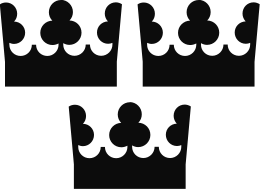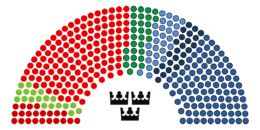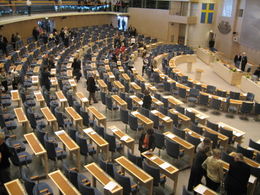Parliament of Sweden
| Swedish Parliament Sveriges riksdag |
|
|---|---|
 |
|
| Type | |
| Type | Unicameral |
| Leadership | |
| Speaker | Per Westerberg, Moderate since 17 September 2006 |
| Structure | |
| Members | 349 |
 |
|
| Political groups |
The Government
The Opposition
|
| Election | |
| Voting system | Semi-open list proportional representation |
| Last election | 17 September 2006 |
| Meeting place | |
 |
|
| Riksdag Building Helgeandsholmen Stockholm, 100 12 Kingdom of Sweden |
|
| Website | |
| Swedish Parliament | |
The Riksdag (officially Swedish: Sveriges riksdag) is the national legislative assembly of Sweden. The riksdag is a unicameral assembly with 349 members (Swedish: riksdagsledamöter), who are elected on a proportional basis to serve fixed terms of four years. It is located in the Riksdag building (Riksdagshuset), on the island of Helgeandsholmen in Stockholm.
Contents |
Name
Riksdag is the direct Swedish equivalent of the German Reichstag. In the Swedish constitution, the word is written with a lower-case r, thus marking that it is actually not a name of the parliament, it is just the parliament.
A precise English translation of this German-Nordic word does not actually exist, but "Meeting of the Realm" may serve as a literal translation, though perhaps "Diet of the Realm" would be more accurate (dag literally means "day", and is thus either cognate to the use of German tag for a Diet, or even a direct borrowing; the former comes from Latin dies with the same meaning). The word is also used by Swedish speakers for the parliaments of Finland (it is the official term used by the Swedish-speaking minority there) and Estonia, and for the old Reichstag of Germany as well as the parliament building in Berlin (reciprocally, "Reichstag" is the standard German translation of "riksdag"). In Sweden riksdag is today also frequently used to refer to the contemporary parliament house of Germany per se (but the Bundestag is called förbundsdag), and sometimes for national parliaments of other countries as well. The word is also used by Norwegian speakers with the same spelling; in Danish it is spelled rigsdag.
Organization
- Speaker of the Riksdag: Per Westerberg (since October 2006)
- Chamber: unicameral with 349 members
- Elections: Members are elected by popular vote on a proportional representation basis to serve four-year terms. In the election year, the elections are held on the third Sunday of September.
- Elections last held: September 17, 2006
Constitution
The riksdag performs the normal functions of a parliament in a parliamentary democracy. It enacts laws, amends the constitution and appoints a government. In most parliamentary democracies, the head of state commissions a politician to form a government. Under the new Instrument of Government (one of the four fundamental laws of the Constitution) enacted in 1974, that task was removed from the Monarch of Sweden and given to the Speaker of the Riksdag. To make changes to the Constitution under the new Instrument of Government, amendments must be approved twice by Parliament, in two successive electoral periods with a general election held in between.
Government
| Kingdom of Sweden |
 This article is part of the series: |
|
|
|
Constitution
Monarchy
Parliament
Judiciary
Divisions
Elections
Foreign relations
Related articles
|
|
Other countries · Atlas |
After holding talks with leaders of the various party groups in the Riksdag, the Speaker of the Riksdag nominates a Prime Minister. The nomination is then put to a vote. Unless an absolute majority of the members (175 members) vote "no", the nomination is confirmed, otherwise it is rejected. The Speaker must then find a new nominee. This means the Riksdag can consent to a Prime Minister without casting any "yes" votes.
After being elected the Prime Minister appoints the Cabinet Ministers and announces them to the Riksdag. The new government becomes effective with a first meeting held before the head of state, the King of Sweden, at which the Speaker of the Riksdag announces to the King that the Riksdag has elected a new government.
Parliament can cast a vote of no confidence against any single member of the government, thus forcing a resignation. To succeed a vote of no confidence must be supported by an absolute majority (175 members) or it has failed.
If a vote of no confidence is cast against the Prime Minister (Sw. Statsminister), this means the entire government is rejected. A losing government has one week to call for a general election or else the procedure of nominating a new Prime Minister starts afresh.
Politics
Political parties are strong in Sweden, with members of the Riksdag usually supporting their parties in parliamentary votes. In most cases, governments can command the support of the majority in the Riksdag, allowing the government to control the parliamentary agenda.
For many years, no single political party in Sweden has managed to gain more than 50% of the votes, so political parties with similar agendas cooperate on several issues, forming coalition governments. In general, two major blocks exist in parliament, the left and the right, or socialists and non-socialists (conservatives/liberals). Currently the liberal/right coalition consisting of the Centre Party, the Liberal People's Party, the Christian Democrats and the Moderate Party governs Sweden. In the previous three electoral periods the socialists formed the government but lost the election in 2006.
| Parties¹ | Leaders¹ | Seats² | Votes³ | |
|---|---|---|---|---|
| Social Democratic Party | Mona Sahlin | 130 | 34.99% | |
| Moderate Party | Prime Minister Fredrik Reinfeldt | 97 | 26.23% | |
| Centre Party | Maud Olofsson | 29 | 7.88% | |
| Liberal People's Party | Jan Björklund | 28 | 7.54% | |
| Christian Democratic Party | Göran Hägglund | 24 | 6.59% | |
| Left Party | Lars Ohly | 22 | 5.85% | |
| Green Party | Maria Wetterstrand and Peter Eriksson | 19 | 5.24% | |
| Total | 349 | 94.32% | ||
| Government Majority | 7 | 2.01% | ||
1/ Party name and leaders current as of March 18, 2007
2/ Seats as per the 2006 general election, current as of March 18, 2007
3/ Percentage of the votes received in the 2006 general election
4/ Members of governing coalition in bold
Elections

All 349 members of the Riksdag are elected in the general elections held every four years. Eligible to vote and stand for elections are Swedish Citizens who turn 18 years old no later than on the day of the election. The next elections are due to be held in september 2010. A minimum of 4% of the national vote is required for membership in Parliament, alternatively 12% or more within a constituency.
Constituencies and national apportionment of seats
The electoral system in Sweden is proportional. Of the 349 seats in the unicameral Riksdag, 310 are fixed constituency seats allocated to constituencies in relation to the number of people entitled to vote in each constituency. The remaining 39 adjustment seats are used to correct the deviations from proportional national distribution that may arise when allocating the fixed constituency seats. There is a constraint in the system that means that only a party that has received at least four per cent of the votes in the whole country participates in the distribution of seats. However, a party that has received at least twelve per cent of the votes in a constituency participates in the distribution of the fixed constituency seats in that constituency.[1]
Most recent election
The Social Democrats suffered their worst electoral result since 1920, while the Moderates recorded their best performance in modern times. As a result the center-right alliance won the election and got control over the Riksdag for the first time since 1994.
| Parties and coalitions | Votes | Permanent seats | Adjustment seats | Total seats | seats %/votes % | |||||||
|---|---|---|---|---|---|---|---|---|---|---|---|---|
| # | % & ±% | # | ± | # | ± | seats & swing | ||||||
| Swedish Social Democratic Party Socialdemokraterna |
1,942,625 | 34.99 |
129 | 1 | 130 |
1,06 | ||||||
| Moderate Party Moderaterna |
1,456,014 | 26.23 |
93 | 4 | 97 |
1,06 | ||||||
| Centre Party Centerpartiet |
437,389 | 7.88 |
27 | 2 | 29 |
1,05 | ||||||
| Liberal People's Party Folkpartiet liberalerna |
418,395 | 7.54 |
22 | 6 | 28 |
1,06 | ||||||
| Christian Democrats Kristdemokraterna |
365,998 | 6.59 |
17 | 7 | 24 |
1,04 | ||||||
| Left Party Vänsterpartiet |
324,722 | 5.85 |
13 | 9 | 22 |
1,08 | ||||||
| Green Party Miljöpartiet de Gröna |
291,121 | 5.24 |
9 | 10 | 19 |
1,04 | ||||||
| Sweden Democrats Sverigedemokraterna |
162,463 | 2.93 |
0 | 0 | 0 |
|||||||
| Feminist Initiative Feministiskt initiativ |
37,954 | 0.68 | 0 | 0 | 0 | |||||||
| Pirate Party Piratpartiet |
34,918 | 0.63 | 0 | 0 | 0 | |||||||
| Swedish Senior Citizen Interest Party Sveriges pensionärers intresseparti |
28,806 | 0.52 |
0 | 0 | 0 | |||||||
| June List Junilistan |
26,072 | 0.47 | 0 | 0 | 0 | |||||||
| Health Care Party Sjukvårdspartiet |
11,519 | 0.21 | 0 | 0 | 0 | |||||||
| National Democrats Nationaldemokraterna |
3,064 | 0.06 |
0 | 0 | 0 | |||||||
| Unity Enhet |
2,648 | 0.05 |
0 | 0 | 0 | |||||||
| National Socialist Front Nationalsocialistisk Front |
1,417 | 0.03 | 0 | 0 | 0 | |||||||
| New Future Ny Framtid |
1,171 | 0.02 |
0 | 0 | 0 | |||||||
| Socialist Justice Party Rättvisepartiet Socialisterna |
1,097 | 0.02 |
0 | 0 | 0 | |||||||
| People's Will Folkets vilja |
881 | 0.02 | 0 | 0 | 0 | |||||||
| Parties with less than 500 votes | 4,766 | 0.08 | – | – | – | – | ||||||
| Alliance for Sweden (Moderate Party, Centre Party, Liberal People's Party, Christian Democrats) |
2,677,796 | 48.24 |
178 |
|||||||||
| Red–green bloc (Social Democrats, Left Party, Green Party) |
2,558,468 | 46.08 |
171 |
|||||||||
| Blank votes | 96,922 | 1.72 | ||||||||||
| Other invalid votes | 2216 | 0.04 | ||||||||||
| Turnout | 5,650,416 | 81.99 |
||||||||||
Members of the Riksdag
47 percent of the Members of the Swedish Parliament are women (2008). This is the world's second highest proportion of females in a national parliament. According to a survey investigation by the sociologist Jenny Hansson [2], Swedish national parliamentarians have an average work week of 66 hours, including side responsibilities. Hansson's investigation further reports that the average Swedish national parliamentarian sleeps 6.5 hours per night.
History

Main articles: History of the Riksdag, Riksdag of the Estates
The roots of the modern Riksdag can be found in a 1435 meeting of the Swedish nobility in the city of Arboga. This informal organization was modified in 1527 by the first modern Swedish king Gustav I Vasa to include representatives from all the four social estates: the nobility, the clergy, the bourgeoisie (propertied commoners in the towns such as merchants, tradesmen, lawyers, etc.), and the peasantry (freehold yeoman farmers). This form of Ständestaat representation lasted until 1865, when representation by estate was abolished and the modern bicameral parliament established. Effectively, however, it did not become a parliament in the modern sense until parliamentary principles were established in the political system in Sweden, in 1917.
On June 22, 1866, the Riksdag decided to reconstitute itself as a bicameral legislature, consisting of Första kammaren or the First Chamber, with 155 members and Andra kammaren or the Second Chamber with 233 members. The First Chamber was indirectly elected by county and city councillors, while the Second Chamber was directly elected by universal suffrage. This reform was a result of great miscontent with the old Estates which were no longer able to represent the people.
By an amendment of the Swedish constitution the general election of 1970 was the first to a unicameral assembly with 350 seats. The following general election to the unicameral Riksdag in 1973 only gave the Government the support of 175 members, while the opposition could mobilize an equal force of 175 members. In a number of cases a tied vote ensued, and the final decision had to be determined by lot. To avoid any recurrence of this, the number of seats in Parliament was reduced to 349 from 1976.
See also
- Referendums in Sweden
References
- ↑ See e.g.: SOU 2008:125 En reformerad grundlag (Constitutional Reform), Prime Ministers Office.
- ↑ "Hansson, Jenny (2008). De Folkvaldas Livsvillkor. Umea: Umea University.". http://www8.umu.se/soc/personal/Jenny%20Hanssons%20avhandlingsarbete.%20Presentation%20samt%20.pdf.
External links
- The Riksdag – official site
- The history of the Riksdag
|
|||||||||||||||||